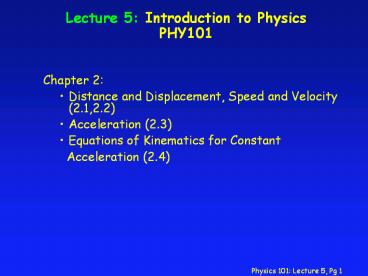Lecture 5: Introduction to Physics PHY101 PowerPoint PPT Presentation
1 / 12
Title: Lecture 5: Introduction to Physics PHY101
1
Lecture 5 Introduction to Physics PHY101
- Chapter 2
- Distance and Displacement, Speed and Velocity
(2.1,2.2) - Acceleration (2.3)
- Equations of Kinematics for Constant
- Acceleration (2.4)
2
Displacement and Distance
- Displacement is the vector that points from a
bodys initial position, x0, to its final
position, x. The length of the displacement
vector is equal to the shortest distance between
the two positions. - ?x x x0
- Note
- The length of ?x is (in general) not the same as
distance - traveled !
3
Average Speed and Velocity
- Average speed is a measure of how fast an object
moves on average - average speed distance/elapsed time
- Average speed does not take into account the
direction of - motion from the initial and final position.
4
Average Speed and Velocity
- Average velocity describes how the displacement
of an object changes over time - average velocity displacement/elapsed time
- vav (x-x0) / (t-t0) ?x / ?t
- Average velocity also takes into account the
direction of - motion.
- Note
- The magnitude of vav is (in general) not the
same as the - average speed !
5
Instantaneous Velocity and Speed
- Average velocity and speed do not convey any
information about how fast the object moves at a
specific point in time. - The velocity at an instant can be obtained from
- the average velocity by considering smaller
and smaller time intervals, i.e. - Instantaneous velocity
- v lim ? t-gt 0 ?x / ?t
- Instantaneous speed is the magnitude of v.
6
Concept Question
- If the average velocity of a car during a trip
along a straight road is positive, is it possible
for the instantaneous velocity at some time
during the trip to be negative? - 1 - Yes
- 2 - No
correct
If the driver has to put the car in reverse and
back up some time during the trip, then the car
has a negative velocity. However, since the car
travels a distance from home in a certain amount
of time, the average velocity will be positive.
7
Acceleration
- Average acceleration describes how the velocity
- of an object moving from the initial position
to - the final position changes on average over
time - aav (v-v0) / (t-t0) ?v / ?t
- The acceleration at an instant can be obtained
from - the average acceleration by considering
smaller and smaller time intervals, i.e. - Instantaneous acceleration
- a lim ? t-gt 0 ?v / ?t
8
Concept Question
- If the velocity of some object is not zero, can
its acceleration ever be zero ? - 1 - Yes
- 2 - No
correct
If the object is moving at a constant velocity,
then the acceleration is zero.
9
Concept Question
- Is it possible for an object to have a positive
velocity at the same time as it has a negative
acceleration? - 1 - Yes
- 2 No
correct
An object, like a car, can be moving
forward giving it a positive velocity, but then
brake, causing deccelaration which is negative.
10
Kinematics in One DimensionConstant Acceleration
- Simplifications
- In one dimension all vectors in the previous
equations - can be replaced by their scalar component along
one axis. - For motion with constant acceleration, average
and - instantaneous acceleration are equal.
- For motion with constant acceleration, the rate
with which - velocity changes is constant, i.e. does not
change over time. - The average velocity is then simply given as
- vav (v0 v)/2
11
Kinematics in One DimensionConstant Acceleration
- Consider an object which moves from the initial
position x0, at time t0 - with velocity v0, with constant acceleration
along a straight line. - How does displacement and velocity of this object
change with time ? - a (v-v0) / (t-t0) gt v(t) v0 a
(t-t0) (1) - vav (x-x0) / (t-t0) (vv0)/2 gt x(t)
x0 (t-t0) (vv0)/2 (2) - Use Eq. (1) to replace v in Eq.(2)
- x(t) x0 (t-t0) v0 a/2 (t-t0) 2
(3) - Use Eq. (1) to replace (t-t0) in Eq.(2)
- v2 v02 2 a (x-x0 ) (4)
12
Summary of Concepts
- kinematics A description of motion
- position your coordinates
- displacement ?x change of position
- velocity rate of change of position
- average ?x/?t
- instantaneous slope of x vs. t
- acceleration rate of change of velocity
- average ?v/?t
- instantaneous slope of v vs. t

